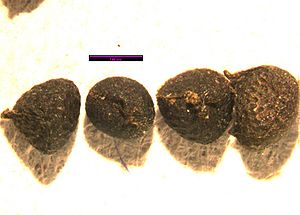Sisyrinchium idahoense
- Scientific Name: Sisyrichium idahoense
- Family: Iridaceae
- English Names: Blue-eyed grass, Idaho blue-eyed grass
- Other Names: Sisyrinchium angustifolium
Contents
Taxonomy
- Kingdom: Plantae
- (unranked): Angiosperms
- (unranked): Monocots
- Order: Asparagales
- Family: Iridaceae
- Subfamily: Iridoideae
- Tribe: Sisyrinchieae
- Genus: Sisyrinchium
- Species: S. idahoense
Description
Showy, tufted perennial to 40 cm tall; stems usually flattened and wing-margined. Leaves mostly basal, long (to 20 cm).and very narrow (< 2 mm broad). Flowers blue to purplish-blue often with a yellow "eye", small (about 2 cm across) and in a terminal cluster of one to five flowers above a pair of sheathing, leaf-like bracts. Fruits egg-shaped capsules to 6 mm long, with black seeds [1]
Bloom Period
May to July
Distribution
Habitat
Ecological Setting
Moist to wet grassy meadows, vernal seepage areas, marshes, roadside ditches; at low to middle elevations [1]
Soil Texture
Fine to well-drained.
Soil Reaction / Salinity
Mildly acidic to alkaline (pH 5.5 to 7.5) [2]
Moisture Regime
Dry to fresh [3]
Shade Tolerance
Full sun to partial shade [3]
Successional Status
Considered a "weedy" species and a good colonizer [4]
Garry-oak Ecosystem Community Status
No information but probably a component of moister meadows in Garry oak ecosystems.
Uses
Site Rehabilitation
Possible reclamation species in moister pockets in selected sites [5]
Wildlife
Solitary bees of the family Megachilidae are mainly responsible for cross-pollination in natural populations. [2]
Landscaping
Mass-plant to create a showy display in a border or a rock garden [3]
First Nations
Infusion of root given to children for diarrhea; Eaten as cooked greens for “regular bowels”; decoction of roots and stalks taken before morning meal for constipation; compound with plant taken for “summer complaint”; infusion of plant taken for stomach troubles and stomach worms; mixed with other greens and eaten.
Propagation
Seed Propagation
Flowers are protandrous, thereby promoting out-crossing and at the same time reducing the chances for self pollination. S. idahoensis is an octoploid species and often exhibits a lag of up to 24 hours between anther maturation and stigma receptivity [2]
Fruit and Seed Collection and Extraction
Collect capsules by hand when ripe into collecting bags. Allow to dry further and then shake bags to extract seeds [6]
Seed Storage
Cold store at 5º C for up to three years [6]
Fruit/Seed Dormancy and Treatment
Seal seeds in a Ziploc-style bag or a Rubbermaid-style container in equal amounts of seed to perlite or vermiculite, and add just enough water to moisten the mixture. Cold stratify at 5º C for 8 to 12 weeks [6]
Outplanting Characteristics and Requirements
Out-plant in the fall to take advantage of natural moisture or plant in spring and provide supplementary watering. Successfully self-seeds in situ. Can be successfully divided in situ in the spring by simply teasing plants apart and replanting the resulting clumps [7]
Photo Gallery
References
- ↑ 1.0 1.1 Pojar and MacKinnon, 1994
- ↑ 2.0 2.1 2.2 Henderson, 1976
- ↑ 3.0 3.1 3.2 Tenenbaum et al., 1994
- ↑ Alverson, 2002
- ↑ Winters, 2002
- ↑ 6.0 6.1 6.2 Schultz et al., 2001
- ↑ R. Bridgeman, pers. comm.
Garry Oak Ecosystems Recovery Team
University of Michigan Dearborn Native American Ethnobotany Database





